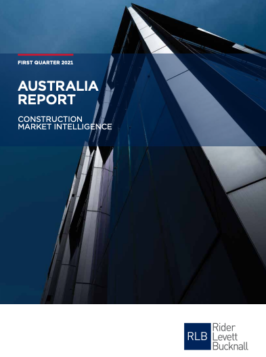According to the Rider Levett Bucknall (RLB) First Quarter 2021 Australia Report, the pressure of pricing has eased in 2021 following on from 2020. All states have seen a substantial reduction in escalation uplifts that were forecast 12 months ago compared to those forecasted now.
Peter Tulla, Oceania Chairman of RLB said, ‘Stable pricing is forecast for 2021 in most cities, with modest increases in escalation expected. This could change quickly if demand heats up or significant disruptions to supply chains (insolvencies, surge in material prices due to global trade conflicts and lack of skilled trade personnel) occur. Current indicators however suggest a more tepid path.’
Strong demand in infrastructure, health and industrial sectors predicted
Looking ahead into 2021, RLB anticipates strong demand in the infrastructure, health and industrial sectors, while weaker activity will be seen in the high-rise residential, hotel and office sectors. Repurposing and/or the refurbishment of retail and office space may also emerge as a strong performer with building owners and landlords looking for new opportunities.
Since the initial supply chain disruptions in Q1 2020 and the differing periods of shutdowns across the states during 2020, RLB offices have mostly seen a reduction of pressure on construction costs mainly due to falling activity within the key cities across Australia.
Impacts of pandemic becoming clearer
Peter continued, ‘With construction activity slightly down across the country and the impacts of the pandemic now being seen in a clearer light, 2020 escalation rates have reduced with Brisbane and Gold Coast feeling the impacts the hardest with a de-escalation rate of 4.1% and 3.5% respectively for the calendar year. Canberra on the other hand has seen little impact with a nominal change to their forecast of twelve months ago.’
With differing levels of activity in all states being seen through 2020 and continuing falls in activity across most sectors in 2021, modest escalation uplifts are being forecasted in all cities. Brisbane and Gold Coast are forecasting a rise of 2.0% for 2021, Townsville 3.0% and Perth 2.7%. Adelaide and Melbourne are forecasting a rise of 1.5% and Sydney 1.2%, up from 0.2% and 1% and zero respectively in 2020.
Entering a period of stability
According to RLB, escalation for the remainder of 2021 and 2022 will depend greatly on the activity levels forecast across all sectors in all states. With the commencement of inoculations against COVID-19, and the current ‘lessons learnt’ approach of state governments, we appear to be entering a phase of stability. This will give rise to a period where wild fluctuations in costs are not seen in tender pricing except where contractors fight to build their future work pipeline.
Wage costs are still impacting future costs with the base rise of 5% per annum over the life of the new NSW EBA still being negotiated. Victoria contractors have agreed to a yearly 3% rise for the next three years. These will have an impact as to the direction of tender price increases during the next eighteen months. Until all these agreements are finalised across the country, future rates of escalation are proving difficult to quantify as labour accounts for a significant proportion of construction costs.
Opposing factors affecting construction costs
Peter noted, ‘Whilst we have seen price increases across the country for structural steel, façades concrete, reinforcement and brick supply, actual tender prices have not yet reflected these material increases to their full extent in all markets. The current consensus across RLB offices is that the general inputs into construction costs are generating several opposing factors.’
‘Reducing construction volumes are likely to increase competition and reduce margins. However, volatile exchange rates, supply chain reliability and changing work practices resulting in lower productivity potentially increasing program durations, are all likely to increase costs,’ he concluded.
The current RLB Tender Price Index annual movements for 2020 and 2021 have been downgraded since they were forecast in Q4 2019 (pre COVID-19). Current forecasts for 2020 and 2021 highlight the difference in annual rates due to the impact of COVID-19.
FURTHER INFORMATION:



